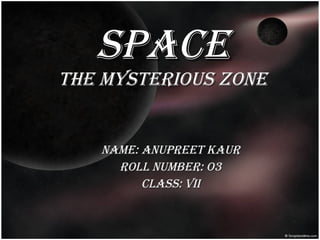
Space
- 1. Space the mysterious zone name: anupreet kaur Roll number: o3 Class: vii
- 2. universe The universe is gigantic. It contains Earth, the planets, the stars, and everything else in outer space. The universe is so big that a spaceship could travel for billions of years without reaching the end of it. It might even go on forever!
- 3. galaxy Galaxy, a massive ensemble of hundreds of millions of stars, all gravitationally interacting, and orbiting about a common center. Astronomers estimate that there are about 125 billion galaxies in the universe. All the stars visible to the unaided eye from Earth belong to Earth’s galaxy, the Milky Way. The Sun, with its associated planets, is just one star in this galaxy. Besides stars and planets, galaxies contain clusters of stars; atomic hydrogen gas; molecular hydrogen; complex molecules composed of hydrogen, nitrogen, carbon, and silicon, among others; and cosmic rays.
- 15. SATURN Saturn, distinguished by its rings, is the second largest planet in the solar system. This processed Hubble Space Telescope image shows the planet’s cloud bands, storms, and rings as they would appear to the human eye.
- 17. Neptune This image of Neptune, taken by the Voyager 2 spacecraft, shows the planet’s most prominent features. The large, dark oval surrounded by white clouds near the planet’s equator is the Great Dark Spot, a storm similar to Jupiter’s Great Red Spot. The smaller dark oval with a bright core below and to the right of the Great Dark Spot is another storm known as Dark Spot 2.
- 19. constellation People have grouped stars into imagined patterns, called constellations, since ancient times. Ancient people created these patterns to remember important people and events. Click on the arrows to learn more about some of the constellations that appear in the skies of the Northern Hemisphere. Following are the name of the constellations ,which people have grouped since ancient times:-
- 28. I HOPE YOU ENJOYED MY PRESENTATION ABOUT SPACE . THANK YOU. CREATED BY- ANUPREET KAUR OF CLASS VII
Notes de l'éditeur
- fgujf